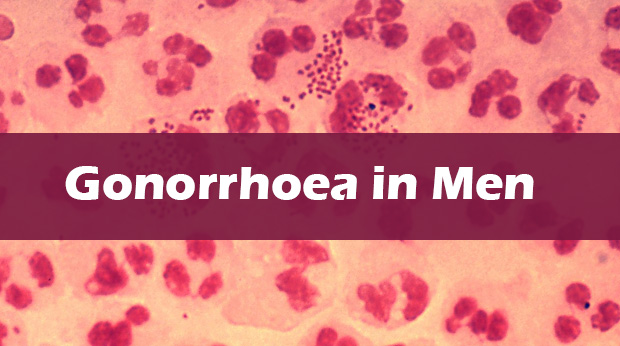Gonorrhoea in Men
Gonorrhoea, a sexually transmitted infection (STI) occurs due to a bacterial growth. The bacterium, Neisseria gonorrhoeae infects areas that are warm and moist in the body of men such as:
- Eyes
- Anus
- Throat
- Urethra (the tube that helps in draining the urine)
Gonorrhoea results due to unprotected anal, vaginal or oral sex and is often seen in people who don’t use condoms and have many sexual partners. These people are at the highest risk of developing this infection due to the nature of the bacterium. Proper usage of condoms, monogamy (having sex with a single partner) and abstinence provides the best protection against this infection. Behaviours in men like illegal drug abuse, alcohol abuse and even IV drug use increases their chances of engaging in unprotected sex. 20% men acquire gonorrhoea from having sex with an infected female.

Causes
The infection is initiated by the bacterium Neisseria gonorrhoeae which affects the mucous membranes of the throat, mouth, rectum and eyes along with the reproductive parts.
The infection results from sexual contact with an infected person which involves vagina, penis, anus and the mouth. And when it comes to men, ejaculation is not at all necessary to acquire or transmit gonorrhoea.
This disease can even be transmitted from an infected mother to its offspring through vaginal childbirth.
Men who are sexually active are at higher risk for acquiring this infection, but it’s highest among young adults, teenagers and African-Americans.
Symptoms
The symptoms of this disease tend to appear around 1to 14 days after the infection is contracted. The symptoms in men include:
- Pain is experienced in the scrotum or testicles
- Frequent and painful urination
- Yellow, green or white discharge from the urethra which resembles pus
- Sore throat, swollen neck lymph nodes which causes difficulty in swallowing
- Swollen, red, warm and painful joints
- Itching sensation and pain experienced during bowel movements including anal discharge
- Pain in the eyes including eye discharge which resembles pus
Diagnosis
The doctor uses a swab for taking a sample of the fluid from the urethra of men for diagnosing gonorrhoea. The specimen is then sent to the lab for analysis. A throat or anal culture may also be given for checking the spread of the infection in the throat and anus. Urine samples are checked for any presence of bacteria using different tests. The tests make take some days for analysis.
Often chlamydia and gonorrhoea occur together, so often, both of them are tested and treated together.
Treatment
Mostly antibiotics are used for curing gonorrhoea infections. A drug-resistant strain of gonorrhoea is emerging as a new challenge. Doctors usually provide an injection of strong antibioticsto treat these bacterias.
Some of the strains of gonorrhoea have developed a resistance to the common antibiotics in the market. In such cases extensive treatment needs to be provided which includes more expensive antibiotics and even combination of different antibiotics. Researchers are still working on developing vaccines to prevent the infection.
Prevention
There are various ways which can help in preventing the transmission of gonorrhoea infection in men. These are:
- Using condoms during anal and vaginal intercourse
- Abstinence
- Using dental dams or condoms during oral intercourse
- Making sure that the other sexual partner has been tested for gonorrhoea and other diseases that are transmitted sexually
- Engaging in sexual activity with unaffected and mutually monogamous partner.

